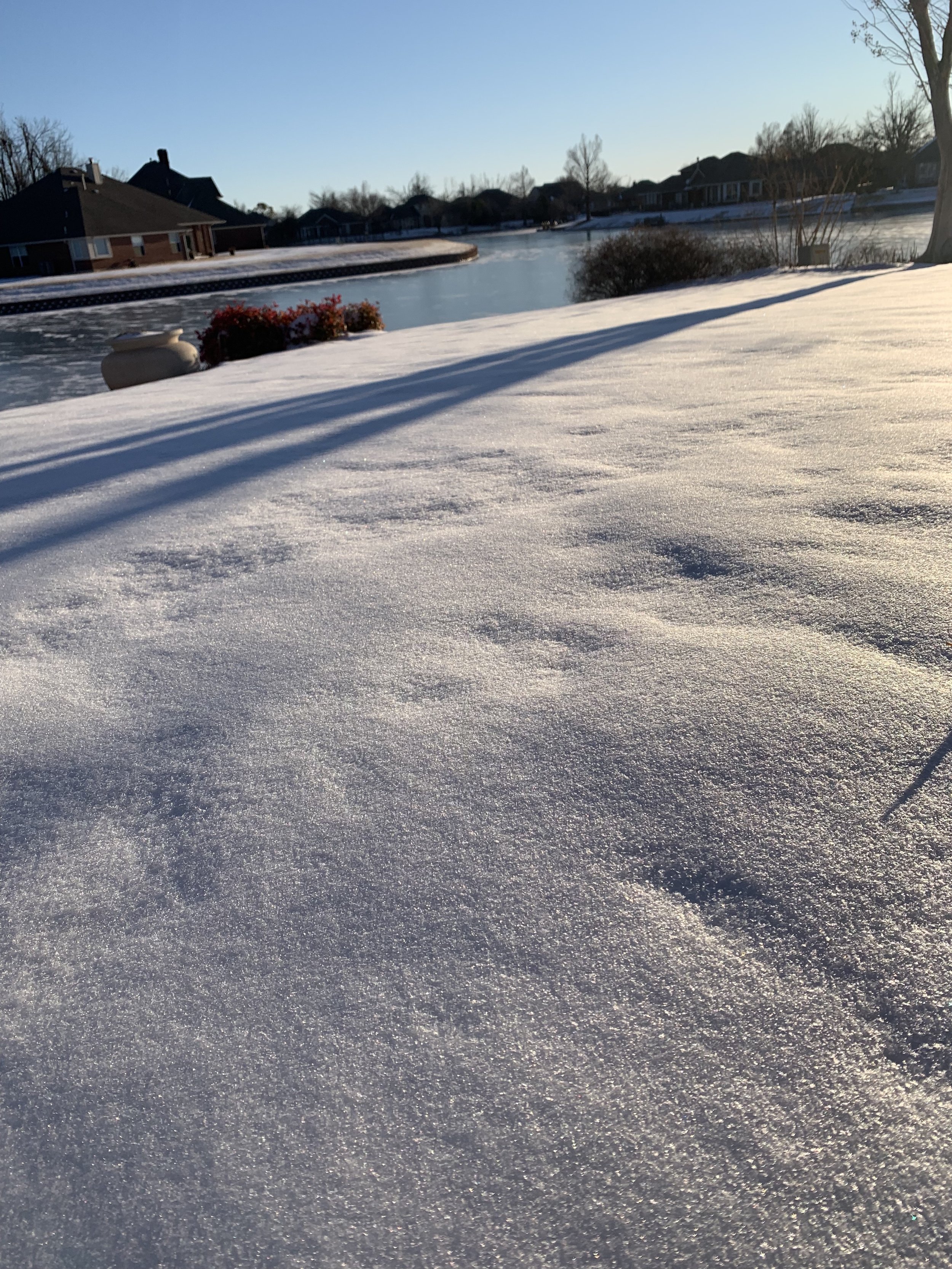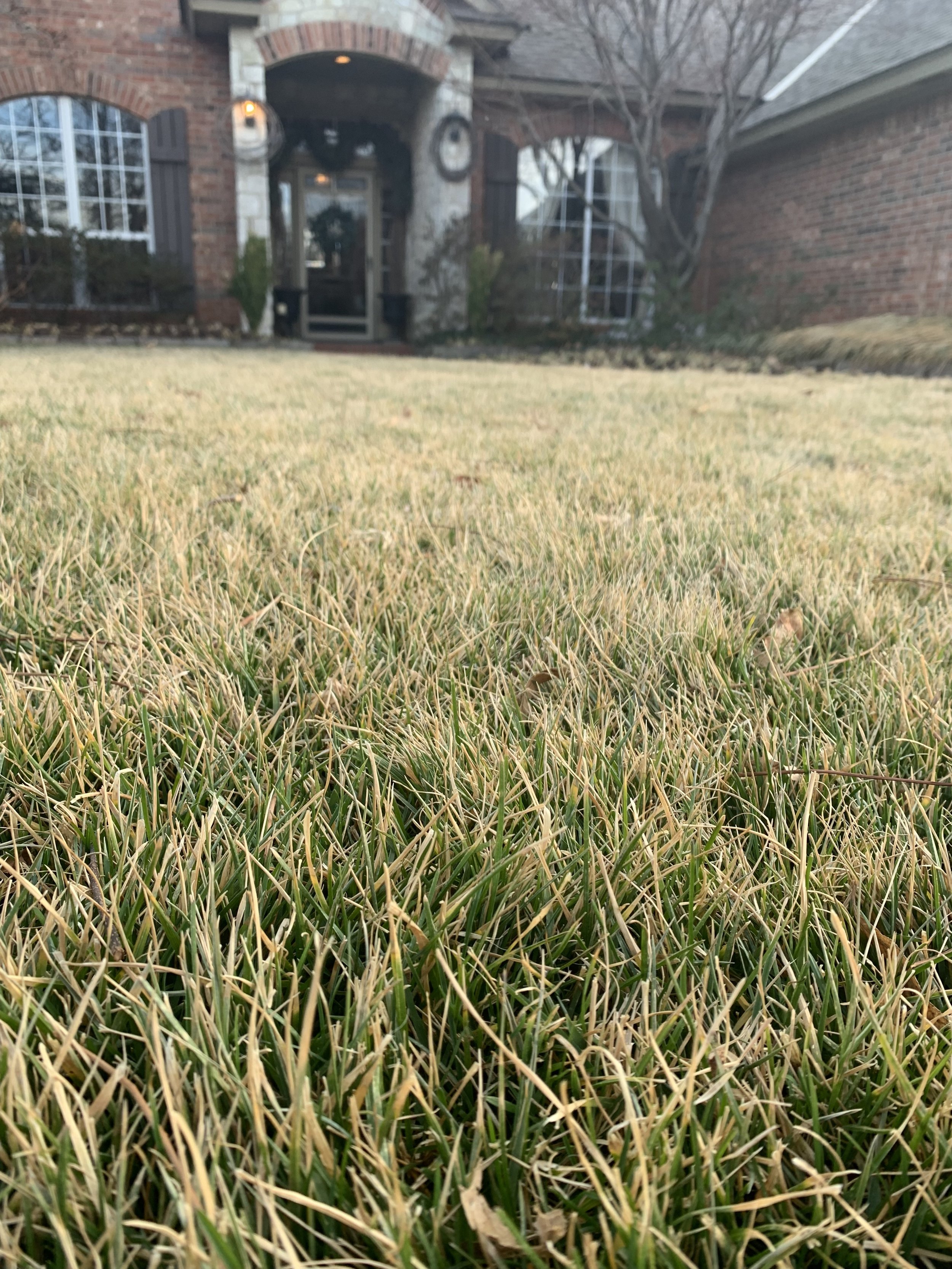What is up with Fescue lawns this winter?
This has been a common question the past couple of weeks, along with:
“Is my fescue dead?”
“Should I reseed my fescue this spring?”
Fescue lawns always lose some color through the winter. Some winters more than others. Others not as much.
What is unique about fescue lawns this winter is how quickly they developed a brown, freeze-burned appearance.
Reasons Why Fescue Lawns Lost Color So Quickly This Winter
We are used to fescue losing some color, but not as suddenly as they did this year.
1. A Cold Snap Without Snow Cover
Anytime temperatures dip below 20 degrees, especially if it is for a few days, fescue’s rich green color starts to fade. But, if there is snow cover, the loss of color is much less.
Just before Christmas, we had a 2-degree night, followed by a 4-degree night, followed by a 9-degree night. The Oklahoma City area had a run of 60 consecutive hours without the temperature rising above freezing.
(Warning: Avoid getting trapped in a conversation at a party with anyone with this type of information.)
Most winters we will have a cold snap in December that leaves fescue a little less green, followed by one that is a little colder in January and followed by another in late January to early February. With each occurrence, a little more green is lost and gradually most fescue lawns appeared mostly brown.
Not this winter.
This winter the single-digit nights in December left fescue lawns with a freeze-burned brown color almost overnight.
Snow cover when temperatures are below 20 degrees is beneficial because it traps warm soil temperatures below the lawn and it keeps freezing temperatures from damaging fescue leaf blades.
With the warm start to January and this weeks rain, fescue lawns are trying to regain their color.
Why is snow cover important? Snow acts as an insulator trapping the warmer soil temperatures below the surface while preventing cold air temperatures from reaching the leaf blades.
Reminder to keep leaves cleaned up on fescue throughout the winter. Even though the fescue isn’t growing and may have lost some color, light is still important for the health of the grass.
If there had been 2-4” of snow covering the landscape just before Christmas, fescue lawns would have had little to no color loss.
2. Dry Fall & Winter
Our lawns and landscapes have been moisture starved since last June. Most of Oklahoma ranges from a severe to extreme to exceptional drought. Over the last four months, we have received less than 50% of the normal precipitation.
(2nd Warning: Avoid getting trapped in a conversation at a party with anyone who knows these things.)
Fescue lawns that have received moisture and are in protected areas have retained more color than areas that are exposed or dry. Also, mature fescue lawns retained more color than the newly developed grass seed this fall.
Winter dissection has left the tips of fescue blades brown. Mow the lawn a little shorter soon to remove the winter damaged leaf blades.
Winter desiccation, a form of winter injury, is the reason for the loss of color in our fescue lawns this year.
Desiccation is the removal of moisture from something.
Desiccation occurs during periods of cold temperatures and drying winds.
Desiccation is minimized when a plant can move stored moisture to the leaves.
If there is a lack of stored moisture or if temperatures are below freezing, the plant is unable to replenish the moisture lost in the leaves resulting in a loss of green color.
There will be a point in late February to early March when temperatures and moisture are just right and suddenly fescue lawns will return to their rich green color.
Dormancy For Bermuda And Fescue Are Very Different.
We are used to bermuda, the most common turfgrass in our region, having one dormancy period per year – winter.
But fescue has two dormancy periods per year – late summer and winter.
Fescue dormancy occurs when temperatures are in the upper 90s or in the low 40s. For fescue, dormancy is when growth slows or completely stops.
When hot summer temperatures arrive, as long as fescue is receiving moisture, the turf retains color, but growth slows. Fescue lawns continue to need mowing, but compared to spring and fall, growth is greatly reduced.
In a typical winter, fescue will stop growing in late November to early December. While never losing all its green color, fescue will gradually turn to a dingy green starting sometime in December and remain off-color through February.
Bermuda growth slows in October as temperatures cool reaching full dormancy by the end of November. When bermuda reaches full dormancy, the leaf blades turn completely brown and become brittle. During bermuda winter dormancy, root development stops.
As temperatures warmed this week, so did soil temperature allowing fescue lawns to start regaining color.
Bermuda grass is like a deciduous tree, such as a maple, when it comes to dormancy. On a deciduous tree all the leaves fall off during winter dormancy and new leaves emerge in the spring.
We can’t wait for the rich green color of fescue to return.
Fescue grass is more like a broadleaf evergreen shrub, such as a holly. During dormancy, the shrub remains green, although the color may not be as rich, and the shrub stops growing. Fescue never goes into full dormancy. As a cool season turf during the winter dormant period root development continues.
When bermuda comes out of dormancy in late March to early April the brown grass left on the lawn does not green up, the plant puts on new growth coming from the roots and stolans.
As fescue comes out of dormancy, the green leaves return to a rich color and the turf starts growing.
How Can You Tell If Fescue Is Dormant Or Dead?
Take hold of grass plant and give a tug. If the plant pulls up easily, it is dead. But if it doesn’t, then the plant is not dead, it is alive. As soon as soil temperatures return consistently to the upper 40’s and there is sufficient moisture color and growth will return.
With warmer than normal temperatures the past two weeks, soil temperatures increasing into the upper 40s, and the ¼” rainfall midweek, we are seeing some color recovery in fescue.
Should You Reseed Your Fescue This Spring?
Unless the turf pulls up when you tug on it (it is dead) or you have bare areas, seeding fescue in the spring is not best. Seeding in the spring is always a band-aid approach. Spring-seeded fescue will come up great, but rarely will it develop enough roots to make it through the summer heat. You will need to reseed the areas next fall. If you need to fill in some areas of your lawn, consider fescue sod in March versus seeding.
Whenever possible, the best approach in the spring, including this spring, is to focus on pre-emergent herbicide applications to prevent weeds, fertilizer to strengthen the turf, and wait until fall to seed.
Between mid-February and early March cut fescue a little shorter than you left it the fall to remove the freeze damaged, brown tips.
When Should You Cut Your Fescue For The First Time?
Between mid-February to early March, cut your fescue lawn a little shorter than you left it last fall removing the freeze-damaged, brown tips.
If you need help determining the condition of your fescue lawn respond to this email or give us a call.
We always enjoy visiting with you about your lawns.
Lorne Hall
Hall | Stewart Lawn + Landscape
(405) 367-3873












